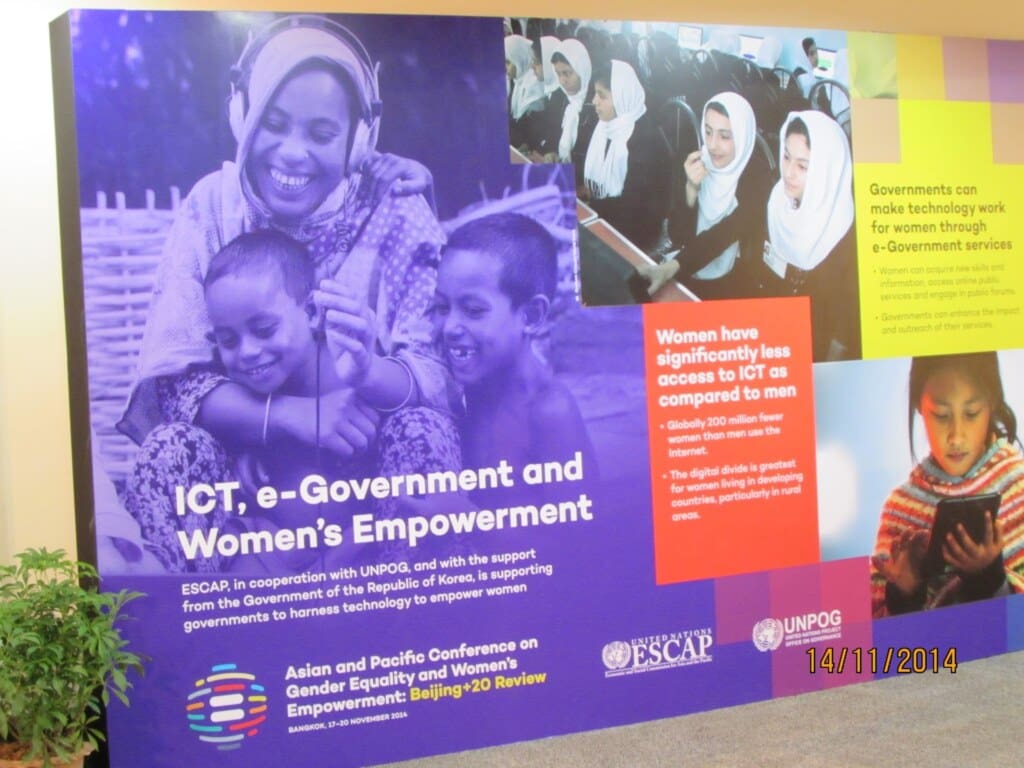Clean air is not a luxury for Louisa and Laila (not their real names), two transwomen who live on Parumaan Island (read: Permaan), one of the islands in the North Sea of Sikka Regency, Maumere City, Flores Island, East Nusa Tenggara (NTT). The only transportation access to the island is using a boat with a capacity of around five gross tonnages.
The coastal sea and houses of Parumaan villagers and Parumaan Solar Power Plant in Sikka Regency.
(Source: Gloria Fransisca/2023)
When the Konde.co team set foot, a number of residents living on the outermost island of Maumere slowly looked at the team’s presence. Along the way around the island, there are stilt houses-made of wood. The ground floor is made openly for relaxing and chatting with family and neighbors. Some residents also use the ground floor for cooking with firewood. At the same time, the upper floor is reserved for the living room to the bedroom.
On the island, there are only a few motorbikes. The number is less than ten. The majority of residents use motorized boat transportation of around 2-3 gross tonnage parked at the only small pier. The boat’s fueled by diesel. The boat is a vehicle for fishing in the Maumere Sea and a mode of transportation for buying and selling basic needs.
According to the records of Parumaan Village, the island stretches for 12 kilometers. -There are about 400-households (KK).
The island’s condition, with its wooden houses and lack of vehicles, keeps the air in Parumaan clean. Not only because there is little vehicle activity but because the energy sector uses renewable energy sources such as solar power plants (PLTS).
The PLTS in Parumaan has been operating since 2019 from the procurement of PT PLN with the implementing contractor PT Tritama Mitra Lestari. This solar power plant (PLTS) has a capacity of 420kWp to serve the needs of around 458 customers. This PLTS operates from the Parumaan village area.
According to Dahil Baco (57), a village official from Parumaan, the presence of electricity in Parumaan since three years ago has indeed been very helpful for the community’s activities for 24 hours. Since electricity came in, most people have installed paid satellite TV. Many people also sell iced tea and fruit iced drinks.
“Nowadays, people can start their own business. They used a magic jar to cook rice. Many have bought refrigerators to sell ice,” he said.
A Parumaan Village resident’s house that now has satellite television. (Source: Gloria Fransisca/2023)
This impact was felt directly by Louisa and Laila, who admitted that the presence of the Parumaan PLTS had helped them increase their income. They do not work as fishermen like most residents but open a grocery store and sell ice cubes. When Konde.co visited there, Louisa and Laila were out looking for merchandise that only existed in Maumere City.
Based on monitoring by Konde.co, Louisa’s kiosk is not too big, only a 3×4 meter plot in front of her stilt house. A similar stall is also owned by Laila. The shop provides a variety of food needs and staples for the residents.
“Yes, I am grateful to be able to open a kiosk business,” said Laila when contacted by Konde.co on December 26, 2022.
Thanks to PLTS, kiosks can be equipped with freezers to sell ice. (Source: Gloria Fransisca/2023)
The NTT region is one of the two regions in Indonesia with great potential for solar energy. Apart from NTT, estimated by the Ministry of Energy and Mineral Resources to have a solar energy potential of 369.5-gigawatt peak (GWp), there is also Riau with 290.41 GWp and South Sumatra with 285.18 GWp. The total reaches 3,294.36 GWp of solar energy potential spread evenly throughout Indonesia.
Based on Konde.co’s observation, apart from Parumaan, other islands in Sikka Regency are also now relying on solar-powered electricity. Call it, among others, Kojadoi Island, Besar Island, Pemana Island, and Palue Island. As quoted from the official website of the Sikka Regency Government, Sikka Regent Francis Roberto Diogo promised to install the next PLTS on Sukun Island, an outer island to the north of Sikka Regency.
The abundant potential for solar energy is also supported by solar radiation, which can reach more than 3.75 kWh per square meter daily. Thus, solar panels can produce electricity to the fullest.
However, the existence of renewable energy in Parumaan is not without its challenges. PLTS Operator and Technical Servant, Sudarman said that maintaining solar energy is tricky. For example, operators must constantly review the quality of photovoltaics (PV) and batteries. PV maintenance in Parumaan is still difficult because PV must be regularly cleaned with clean water. Little clean water in Parumaan makes PV treatment currently only uses rainwater.
“We have to get clean water from the opposite island. We still get the rainwater from Kojadoi Island, whose installation is flowed here,” said Sudarman.
Photovoltaic solar power plant (PLTS) Parumaan. (Source: Gloria Fransisca/2023)
Apart from maintenance, another concern is the air quality monitoring equipment in the East Nusa Tenggara region located in Kupang City, which has experienced problems that have not been repaired. According to the Head of the Office of the Meteorological Station at Frans Seda-Maumere Airport, Ota Thallo, there was not much air pollution found in the NTT region because the rejuvenation of equipment has never been a priority for the government.
“As a result, data for air quality has not been optimally utilized here,” Ota told Konde.co.
According to Otha, in eastern Indonesia, including East Nusa Tenggara, there are only few air quality monitoring tools in Indonesia because procurement is very dependent on the priority scale. “Perhaps because pollution is relatively low in NTT, here [Maumere], there are also no factories, and vehicle pollution is not that much,” said Ota.
In contrast to the condition of Parumaan, Maumere, the capital city of Indonesia-Jakarta, is no better than the area known as MOF, commonly called Maumere of Flores.
Jakarta is still struggling with the problem of air pollution that never ends. World Air Quality1]2]3]4] data for the last four years shows that air pollution in Jakarta is one of the worst in the world. Jakarta consistently occupies the top ten worst-polluted cities in the world and in Southeast Asia.
Every year, the average concentration of particulate matter with a diameter of 2.5 microns (PM2.5) in Jakarta is four to five times higher than the WHO Air Quality Guidelines standard. The number of deaths associated with PM2.5 in Jakarta is the largest nationally, namely around 36 people per 100,000 people at the national level. A study by Budi Haryanto et al. estimates that in 2010 there were 5.5 million cases of air pollution-related illnesses, or nearly 11 cases per minute, in Jakarta, costing the equivalent of 60 trillion in 2020.
The Vital Strategies study with the Bandung Institute of Technology during the period October 2018-September 2019 identified the primary sources of Jakarta air pollution, namely vehicle emission, coal combustion for Steam Power Plants (PLTU), open burning, construction, road dust, and suspended soil particles.
In addition, the Center for Research on Energy and Clean Air (CREA) research in 2020 entitled “Transboundary Air Pollution in the Provinces of Jakarta, Banten, West Java,” found strong indications of cross-border pollution from Banten and West Java Provinces, which are the main contributors to air pollution in Jakarta.
Surrounding the capital city, at least 136 registered industrial facilities (including power plants) operate in high-emission sectors in Jakarta and are located within a 100 km radius of Jakarta’s administrative boundaries. In detail, 16 are located in DKI Jakarta, 62 in West Java, 56 in Banten, one each in Central Java and South Sumatra.
Quoted from research, satellite imagery monitoring shows that the Suralaya power plant in Banten is operating and producing emissions as usual during the Covid restrictions. The wind brought the pollution of the Suralaya power plant to Jakarta, which may have contributed to the continued high PM2.5 in Jakarta, despite the major reduction in local traffic and urban activity.
“The operation of these high-emission sectors produces air pollution and has a significant impact on Jakarta’s air quality,” said Erika Uusivuori, a CREA researcher.
The research also explained that meteorological factors such as wind trajectories affect the spread of pollutants such as NO, SO2, and PM2.5. In the dry months of May-October, sources from coal-fired power plants and industrial plants east of Jakarta (from Bekasi, Karawang, Purwakarta to Bandung) have a greater impact on air quality. In the wet months (December-March), sources, west-particularly the Suralaya power plant in Banten-are a more prominent contributor to pollution.
“All of these factors affect Jakarta’s airspace and Jakarta’s air pollution as a whole,” she said.
Frustrated by the constant dirty air, on July 4, 2019, dozens of Jakarta residents, together with attorneys for the Jakarta Capital Movement Advocacy Team (Universal Coalition Clean Air Initiative), filed a citizen lawsuit for Jakarta’s poor air quality to the Court Central Jakarta State. They sued President Joko Widodo, the Minister of Environment and Forestry, the Minister of Home Affairs, the Governor of Jakarta, the Governor of West Java, and the Governor of Banten.
Two years on, in September 2021 to be precise, the judge partially granted the lawsuit with case number 374/Pdt.G/LH/2019/PNJkt.Pst. President Joko Widodo and members of his cabinet, and three provincial governors were found guilty of failing to tackle Jakarta’s air pollution. The judge penalized President Joko Widodo to set national ambient air quality standards.
While the members of his cabinet: The Minister of Environment must supervise the regional heads of the three accused provinces in terms of i cross-border emissions inventory of the three provinces, the Minister of Home Affairs must supervise and guide the performance of the Governor of DKI in controlling air pollution, and the Minister of Health to perform calculations on the reduction of health impacts due to air pollution in DKI Jakarta Province.
The DKI Jakarta administration accepted the decision without appeal. Meanwhile, President Joko Widodo and members of his cabinet appealed, then lost at that level of appeal.
Head of the Environmental Impact Management Sector, DKI Jakarta Provincial Government (Pemprov) Environment Agency, Yusiono A. Supalal, explained that after losing in court, DKI Pemprov decided not to take any steps to appeal. “The DKI Provincial Government has chosen to accelerate efforts to control air pollution,” he answered when asked by Konde.co in a public discussion “Guarding the Jakarta Clean Air Governor Regulation, Wednesday (25/1/2023).
He then explained that the tactical steps taken by the DKI Provincial Government after the lawsuit were to issue Governor Instruction No. 66 of 2019 concerning Air Quality Control. The instruction contains seven action plans to control air pollution by monitoring emissions from stationary sources, testing motorized vehicles, and other emission sources.
“Until now, we are still making efforts. Including the issue of air quality monitoring that was also sued, from the collaboration, we were finally able to get an additional 14 air quality monitoring devices. We will publish the data results on the DLH website,” he added.
Yusiono explained that the Provincial Government of DKI Jakarta has also developed a Jakarta Air Pollution Control Strategy 2023-2030. The three major strategies that will be implemented are improving air pollution control governance, reducing air pollutant emissions from mobile sources, and reducing air pollutant emissions from immobile sources.
Meanwhile, President Joko Widodo and Minister of Environment and Forestry (LHK) Siti Nurbaya Bakar recently took another legal step by filing a cassation against a citizen’s lawsuit over the right to clean air.
“We have done everything requested by the plaintiff, but what has been done has not been considered in the decision. That’s why we are taking the cassation legal steps,” answered Sigit Reliantoro, Director General of Pollution Control and Environmental Damage of the Ministry of Environment and Forestry, through a written document to Konde.co, Monday (30/1/2023).
On the other hand, the actions taken by the President and the Ministry of Environment and Forestry are considered by the civil society coalition as an act of the government that is reluctant to care about public health.
“We from the coalition see that President Jokowi and Mrs. Siti Nurbaya Bakar are very serious in fighting their citizens,” said Jihan Fauziah Hamdi, attorney for the Advocacy Team for the Capital City Movement when contacted by Konde.co by telephone on Wednesday, January 25, 2023.
According to her, after being convicted, the government should immediately focus on improving and carrying out its responsibilities in terms of fulfilling and protecting the environment, especially in this case, Jakarta’s air pollution. Even though she regretted the government’s cassation submission, Jihan admitted that the legal team would still immediately respond to the legal steps taken by the President and Minister of the Ministry of Environment and Forestry.
“We have a time limit of 14 calendar days to respond through a counter-cassation memorandum of the arguments submitted by the President and the Ministry of Environment and Forestry through the cassation memorandum document,” she added.
In addition, the government has revised Government Regulation 41 of 1999 concerning Air Pollution Control, a regulation that regulates air quality standards by revoking it through issuing a new regulation, Government Regulation Number 22/2021, concerning the Implementation of Environmental Protection and Management. In this latest regulation, the government does not reduce the annual ambient PM2.5 limit by 15 µg/m3. This limit is three times higher than the latest WHO standard of 5µg/m3.
“Before adopting WHO guideline values as standards, the government must consider local conditions that are unique to each country,” explained Sigit.
According to Vital Strategies researcher Ginanjar Syuhada, the government should set a safe limit for air quality. However, he explained that the WHO standard of 5ug/m3 is not immediate, but it was carried out in stages according to the interim target. Referring to WHO, the determination of Indonesia’s annual ambient PM2.5 limit is already in line with the limit at the IT-3 level (interim target 3).
“Ideally, Indonesia should set a minimum limit as low as possible to protect society from the various negative impacts of air pollution. However, this reduction must be realistic by considering various things that occur in the field, according to the local context,” he replied.
***
This coverage received grant support from the Internews & Earth Journalism Network (EJN) to cover the issue of air pollution in Jakarta.













